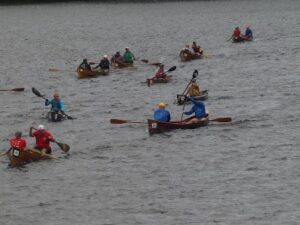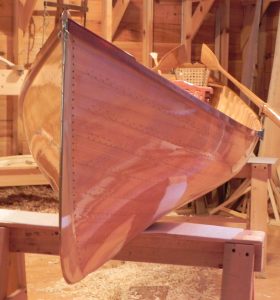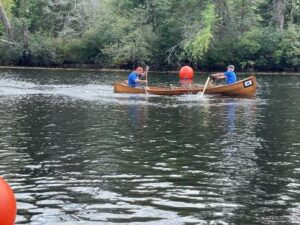Jon writes: “Day 3 dawned with a steady, ominous wind in the trees above the hotel, a forbidding sign of things to come…We started in Square Pond at Fish Creek Ponds Campground. From there we wound our way through a twisty channel into Upper Saranac Lake. (The three Saranac Lakes, Upper, Middle and Lower are linked together in a U shape).
Before reaching Upper Saranac Lake, there is a bottleneck caused by a bridge the racers must squeeze under. To make matters worse, a group of Tourist Class boats were started just before our flight. (Tourist Class paddlers are non-competitive kayakers or canoeists just in the race to finish) Jon says ” We ran into a jumbled mess of Tourist Class racers. This was because the Director started our wave only moments later than theirs. We weaved our way through the boats as best we could, announcing our approach. It was a mass of boats to navigate through and made for a thrilling start.
Below is the convergence of guideboats, kayaks, and canoes as they all try to get under the bridge. The “wingspan” of a guideboat, counting the 3 foot beam plus at least 6 feet of oar on each side, is around 15 feet. This makes it harder for a guideboat to maintain forward momentum in tight situations. With the oars tucked in, the helmsman is the only source of propulsion.

Jon and Kevin succeeded in being the first guideboat under the bridge. “However, there was one two-person guideboat that was committed to staying with us. They gave us chased the entire day.
Upper Saranac (Lake) was a washing machine of white capped rollers, pushing us and pulling us and at one point nearly pitch poling us. The big water between Dear Island and Doctors Island was the heaviest. It caused us to surf down the biggest waves. I recall looking down on Kevin and thinking “We might go over”. I was so far up in the air that my paddle couldn’t dig in a brace stroke.”
Gordon here: Jon and Kevin are in real peril. The waves have become so high that they lift Thankful’s stern out of the water. At the same time, they threaten to drive her bow into and under the forward wave. If her bow is driven under water, it could cause Thankful to flip over upside down (pitch pole).
Fortunately, the old school guideboat builders recognized this danger and designed the hull to avoid catastrophe. The shear line of guideboats rises upward rather abruptly at both the bow and stern. This adds more buoyancy where it is most needed. Decks, fore and aft, help prevent seas from entering the boat should the bow be submerged.
Here is a photo of a reproduction of a guideboat originally built by Warren Cole. It shows the upsweep of the shear line at the bow.

There is another route to disaster that could end the race for Kevin and Jon. Their boat could slip sideways down the face of a wave and flip over, dumping Jon and Kevin into the Lake. Race over!…..
How to keep this from happening? Jon is hindered from using his paddle to “brace” the boat and keep it perpendicular to the waves. As said above, much of the time the stern is so high above the waves that his paddle is useless. That leaves it to Kevin. He must maintain forward momentum , pulling hard on the oars as best he can in these very rough seas. One of the main obstacles is, strangely, the oars. They are pinned meaning he can’t feather them With oars that can be feathered you can rotate them on the recovery stroke so the blade is parallel to the water. With pinned oars there is a greater chance of “catching a crab” as experienced rowers put it. By that they mean the oar strikes the crest of a wave before the recovery stroke is finished. This can pull the boat off course, feeding directly into sliding sideways down a wave and capsizing. So, on the return stroke, Kevin must keep the oars up high, well above the chaos of the churning lake.
Jon and Kevin finally reach safety as they round Doctors Island. They are on the lee side of the island, blocked from the strongest gusts and horrific waves. Next is Bartlett Carry. Jon continues “We arrived at Bartlett Carry only moments in front of the next guideboat. That boat was committed to keeping us at full pace despite our extensive lead time. We ran as fast as we could down the hill of the Carry to Middle Saranac Lake. There we got into the water quickly.
As we left the Carry behind the water was calm until we made the turn into the main lake. Feeling like we gained a bit we relaxed and focused on efficiency. The wind was now cross our beam and lapped at the hull. Things became quite bouncy as we headed towards the Saranac River. As we approached the shallow river the seas became quite confused, pushing us into the channel. Tricky stuff! But Thankful handled it well.
Next was the carry around the Upper Lock. (Should you choose there are hand-operated locks for power boats and such. They get you around the rapids on the Saranac River. Obviously, Jon and Kevin choose not to use them today as they would take too much precious time.)
Once around the lock the course proceeds into Lower Saranac Lake. Here the boats pass Devil’s Pulpit Rock formation. It is named from a Native American legend of a young man who jumped to his death after being spurned by a woman of his interest.
Lower Saranac Lake returns to the Saranac River again and the lower lock. The carry around the lock is steep up and then down and is the final carry. After the carry we jumped back into Thankful, now onto Oseetah Lake. We had about a 5 minute lead so I confidently suggested a shortcut to pad our lead. We had used it in the spring during the Round the Mountain Race. This is where races are won or lost…
We ran aground in the short cut, forcing both of us to jump into the mucky water up to our knees to pull the boat through. We lost a minute here as the other team chasing us opted to go around and avoid the quagmire we were wading through. We jumped back into Thankful, covered in mud, and back into the channel. The other boat was about 100 yards behind us and quickly gaining.
I quietly asked Kevin if he had anything left in the tank. He was on oars and said he did. We put the hammer down and he dug down and so did I. We pushed as hard as we did at any other point during the entire three days. It was a 40 minute sprint through Lake Oseetah and Lake Flower.
We crossed the finish line about a minute in front of the next boat. Phew!”
